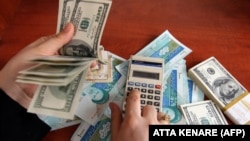Iran’s financial markets reacted nervously to reports that U.S. President Donald Trump may decertify the nuclear agreement (JCPOA) with Tehran. The value of rial, Iran’s national currency started to drop in recent days as investors fear that the United States may leave the nuclear deal and impose new sanctions on their country.
For the first time in 2017, the rate of one U.S. Dollar exceeded 40,000 rials over the weekend. The value of Euro and British Pound have also shown significant increases.
The recent decision of Iranian Central Bank to lower interest rates for long- and short-term deposits from over 20% to 15% and the independence referendum in Iraqi Kurdistan have also contributed to jitters in the financial markets, but the major reason was the expected announcement of a tougher U.S. policy towards Iran, Fereydoun Khavand, Professor of Economics in Paris told Radio Farda.
While domestic opponents of President Hassan Rouhani accuse his government of intentionally weakening the value of the Iranian rial, Khavand disagreed saying that Rouhani’s government would do its best to prevent the devaluation of the rial by injecting foreign currency into the market.
But people are concerned about the possibility that the JCPOA might start to unravel following Trump's announcement.
A law passed by the U.S. congress in May 2015 requires the president to re-certify Iran’s compliance with the deal every 90 days. Ahead of the next deadline on October 15, reports suggest that President Trump may refrain from doing so.
On social media, Iranians report of long lines in front of currency shops.
"Today, I saw people at Ferdowsi square standing in line to buy dollars at 40,300 rials, the same people who were saying one dollar will be worth 10,000 rials, on the day when JCPOA was signed,” an Iranian user wrote on his Twitter account mocking the deal.
Another one connected the current situation with a famous slogan of Ayatollah Khomeini, the founder of the Islamic Republic of Iran in a sarcastic comment:
“In a country that a threat by the U.S. president cripples the economy, all walls are decorated with the slogan ‘U.S. cannot do a damn thing’."
But not everybody sees the probable move by President Trump as the main reason for the spike in foreign currency rates.
Abolghassem Hakimi Pour, Professor of Economics at Allameh Tabatabaei University in Tehran said in an interview with semi-offical Fars News Agency that the trend had to do with the plan of Iran’s central bank for having a unified currency rate.
Currently, foreign currencies are traded at two different rates; one a free market rate, which was at around 40,700 rials to the dollar on Thursday and an official rate offered to some by the government for subsidized transactions such as vital imports, set by the central bank at around 34,149 rials.





